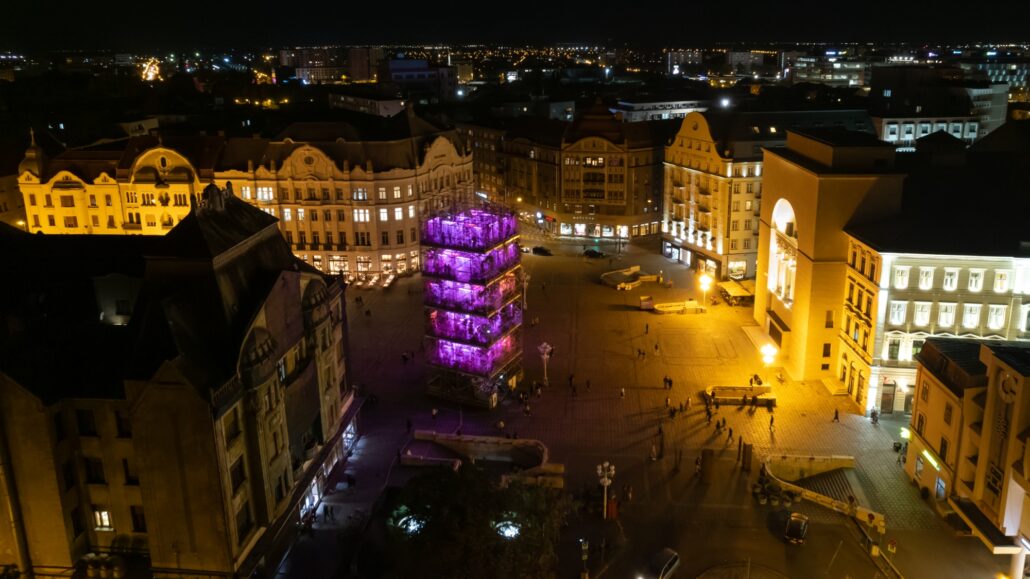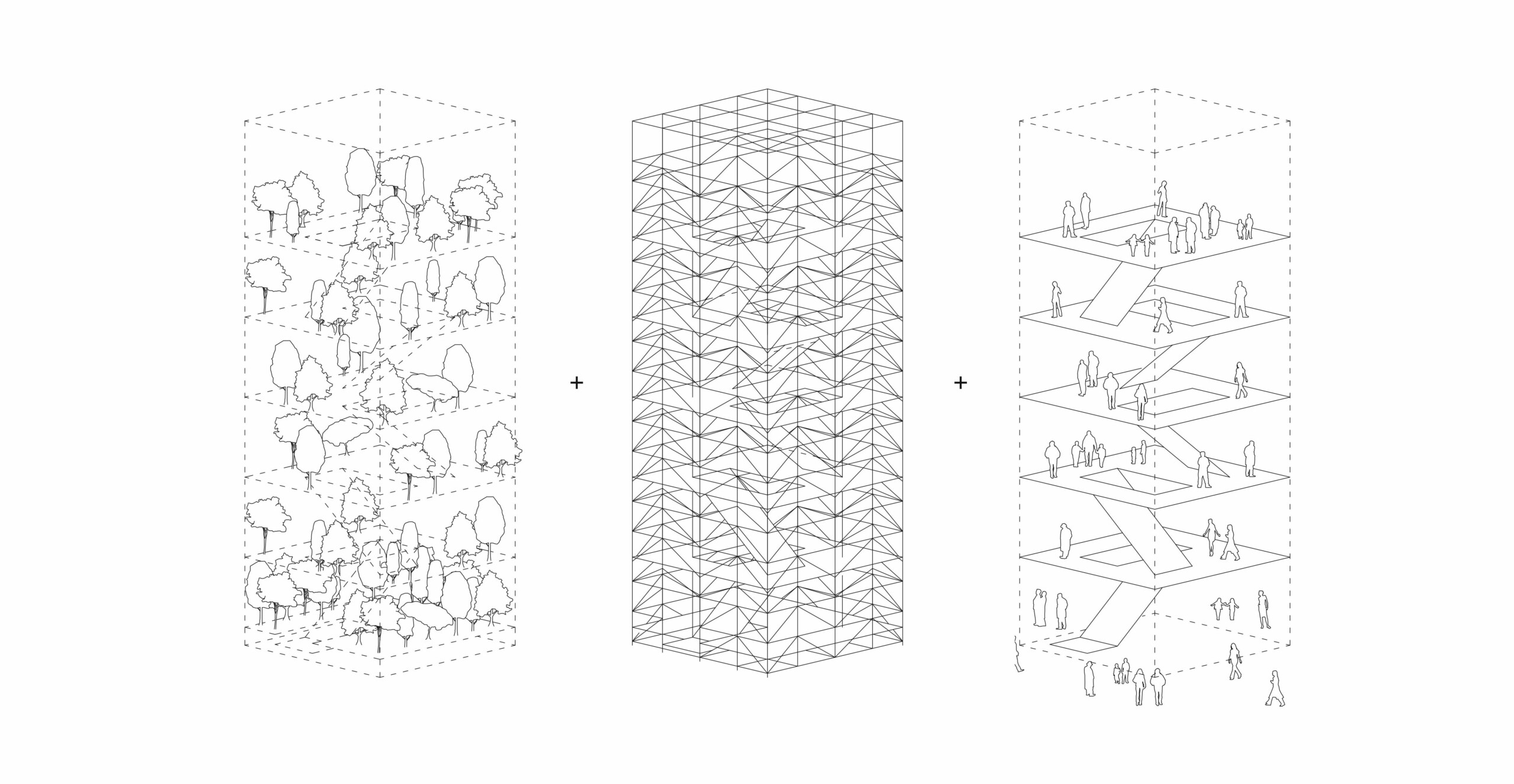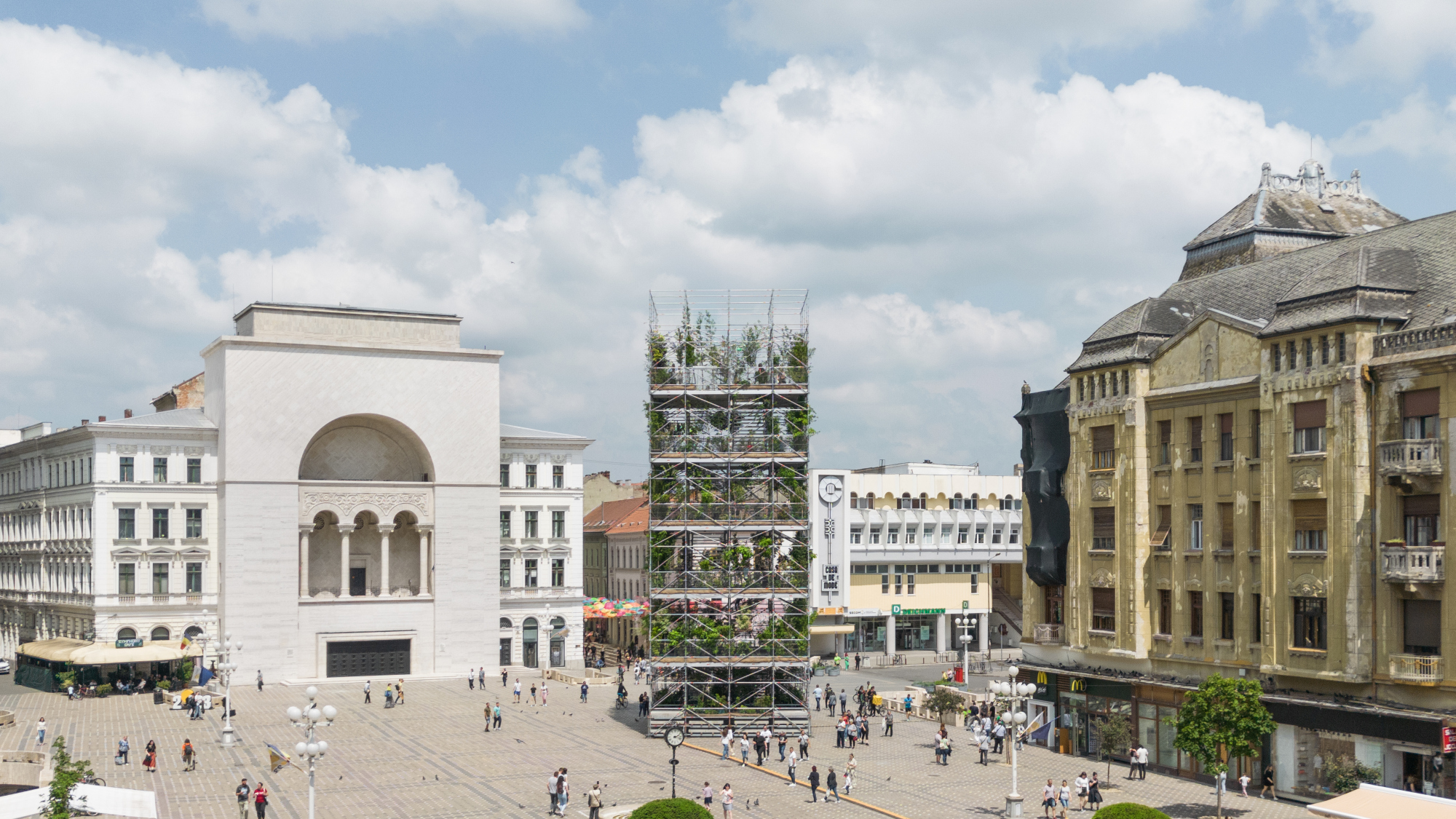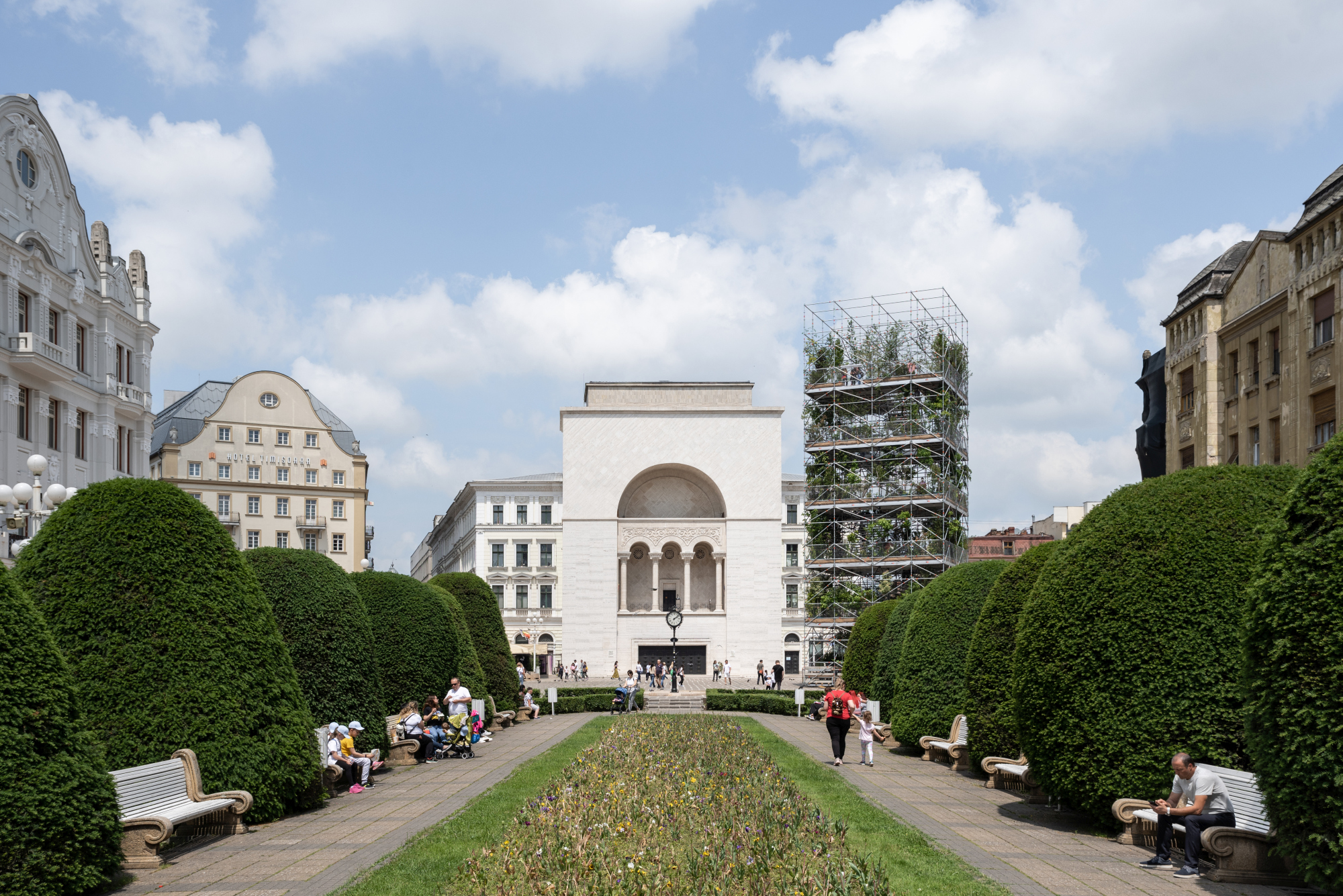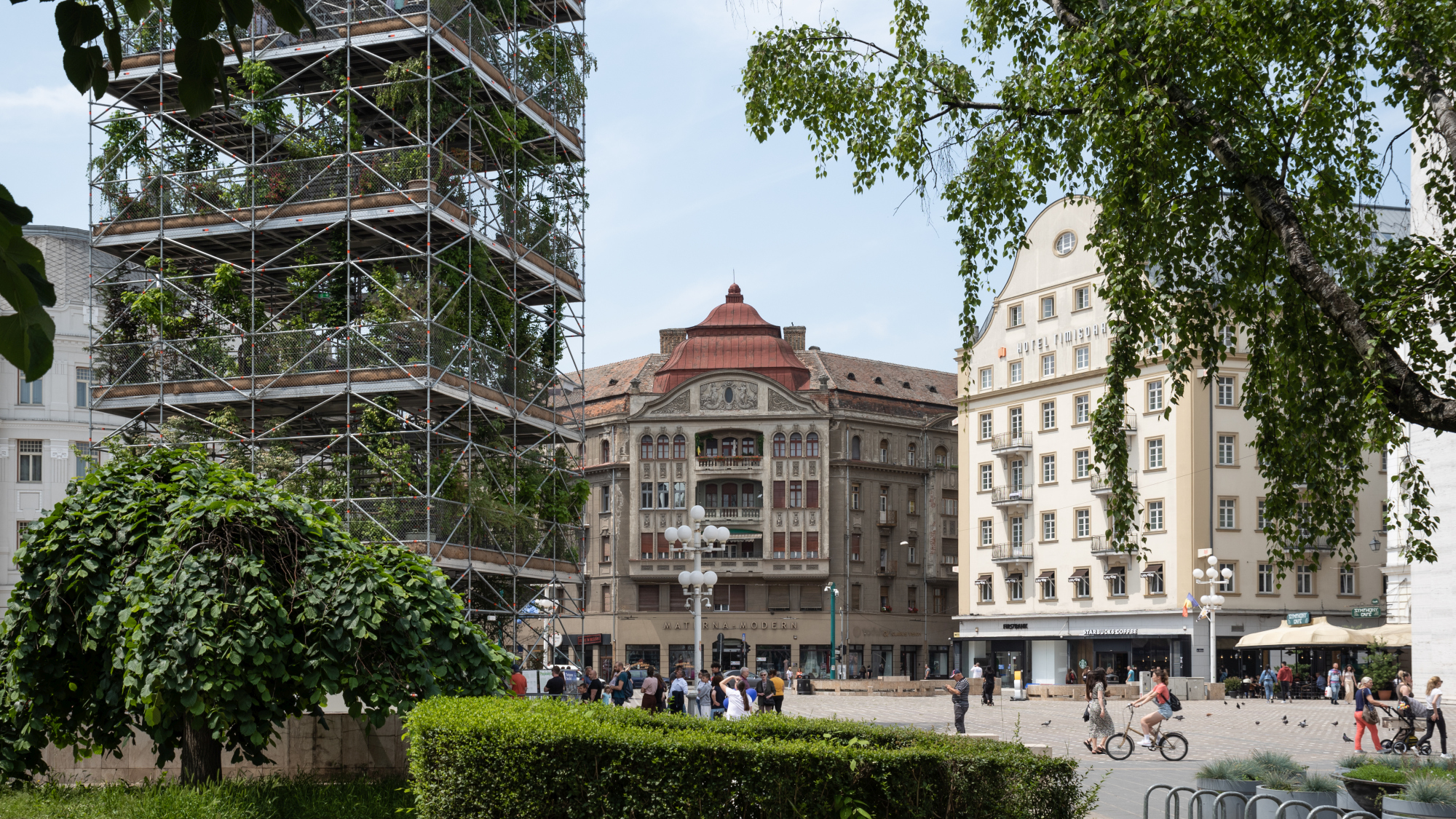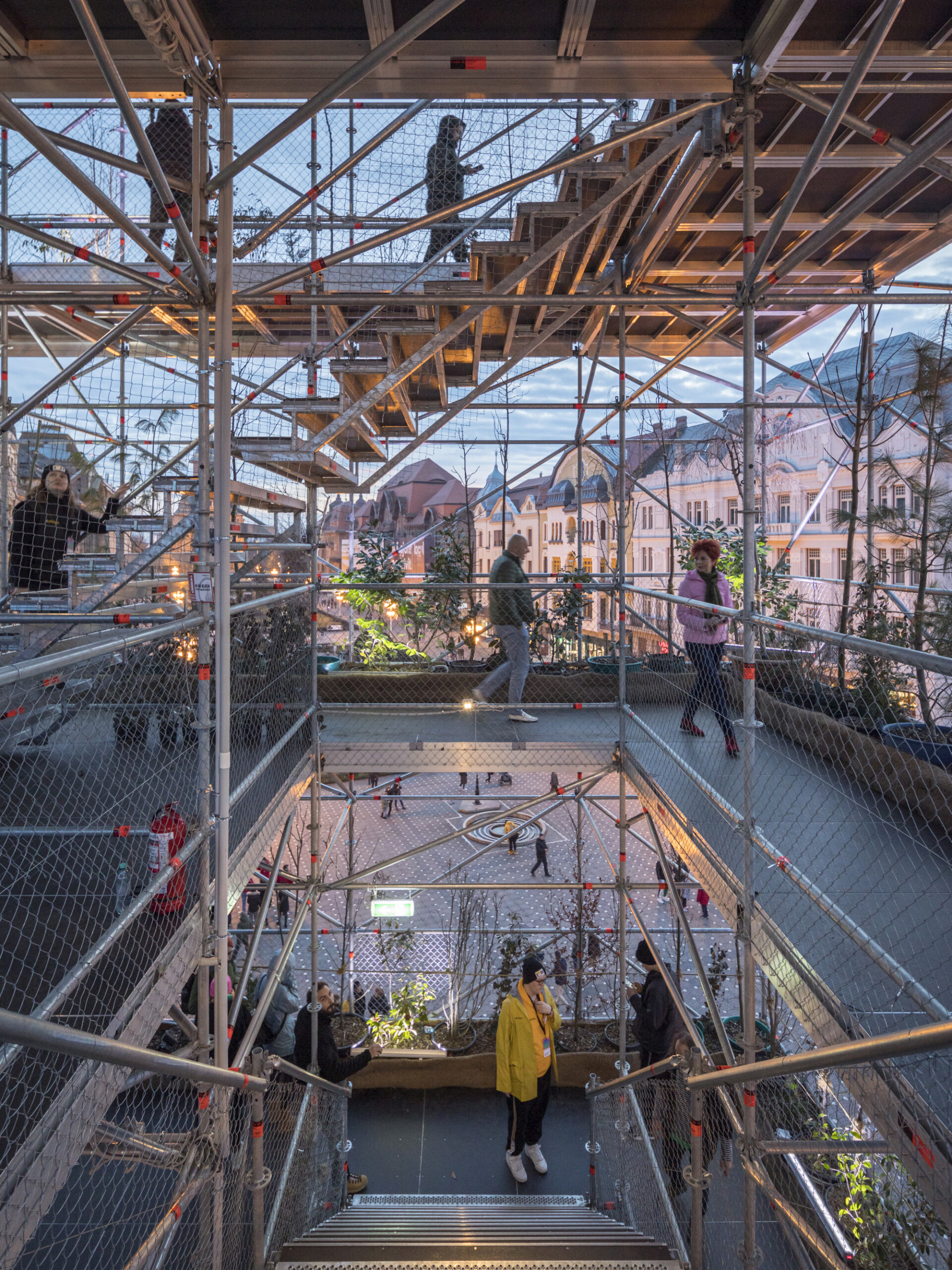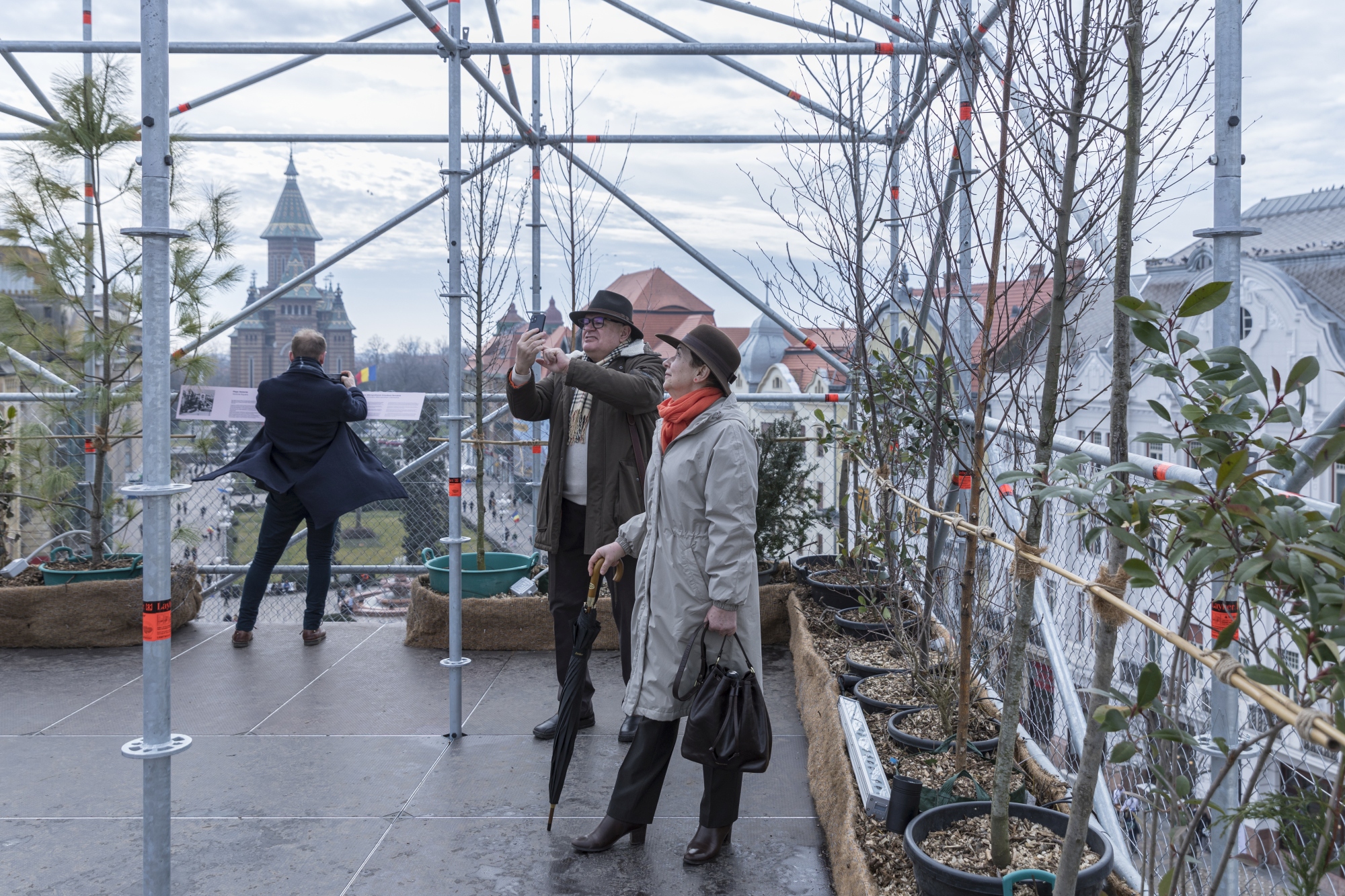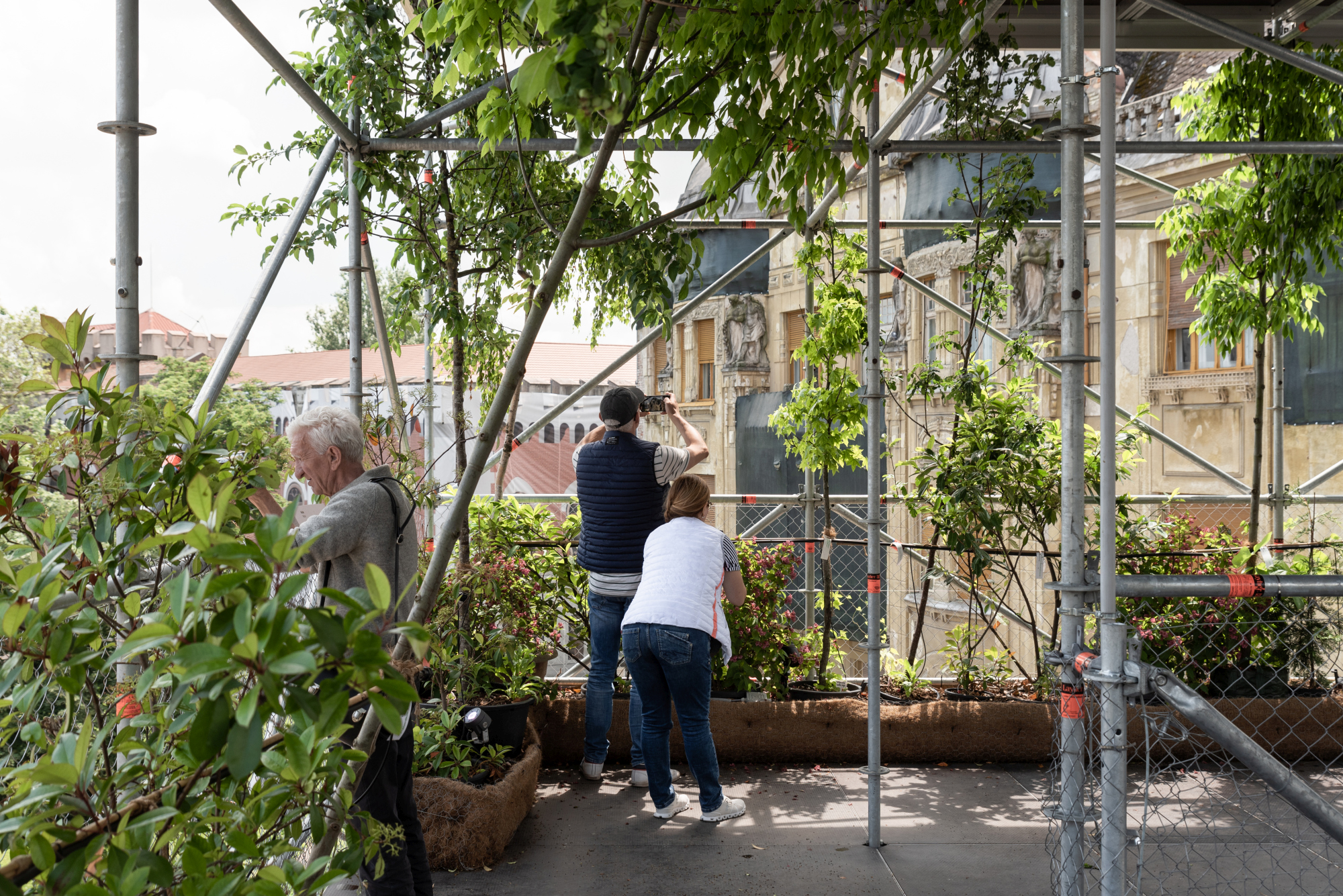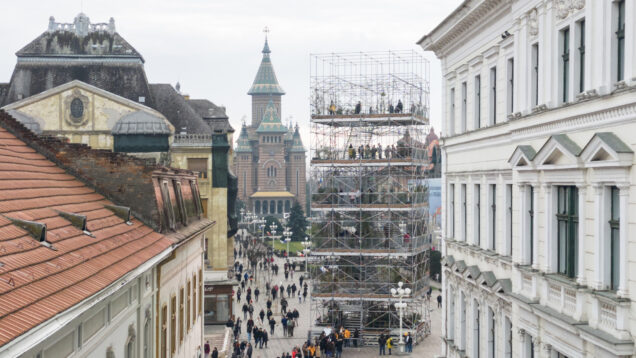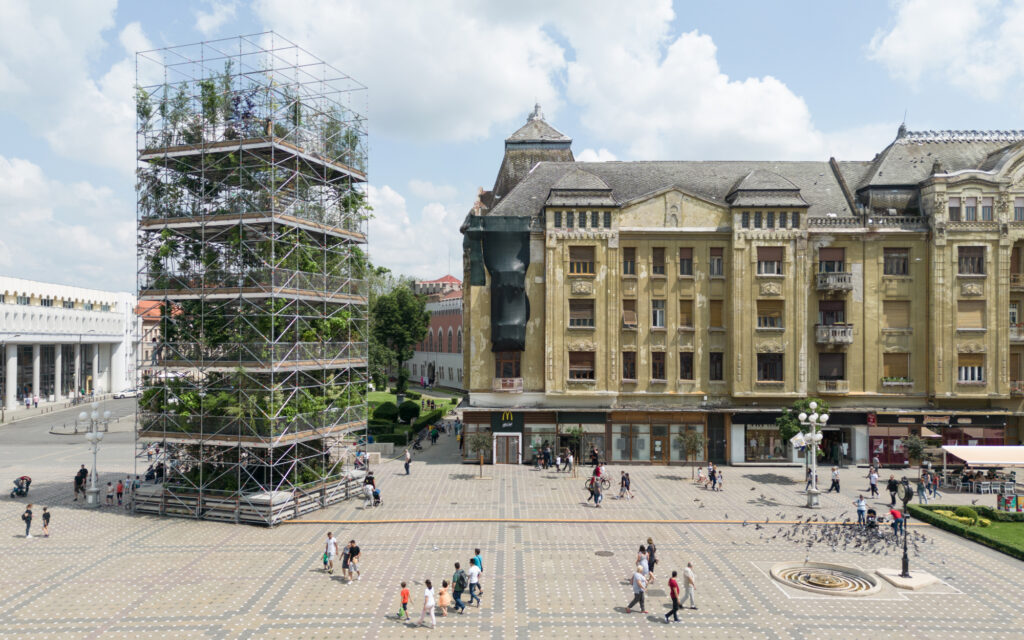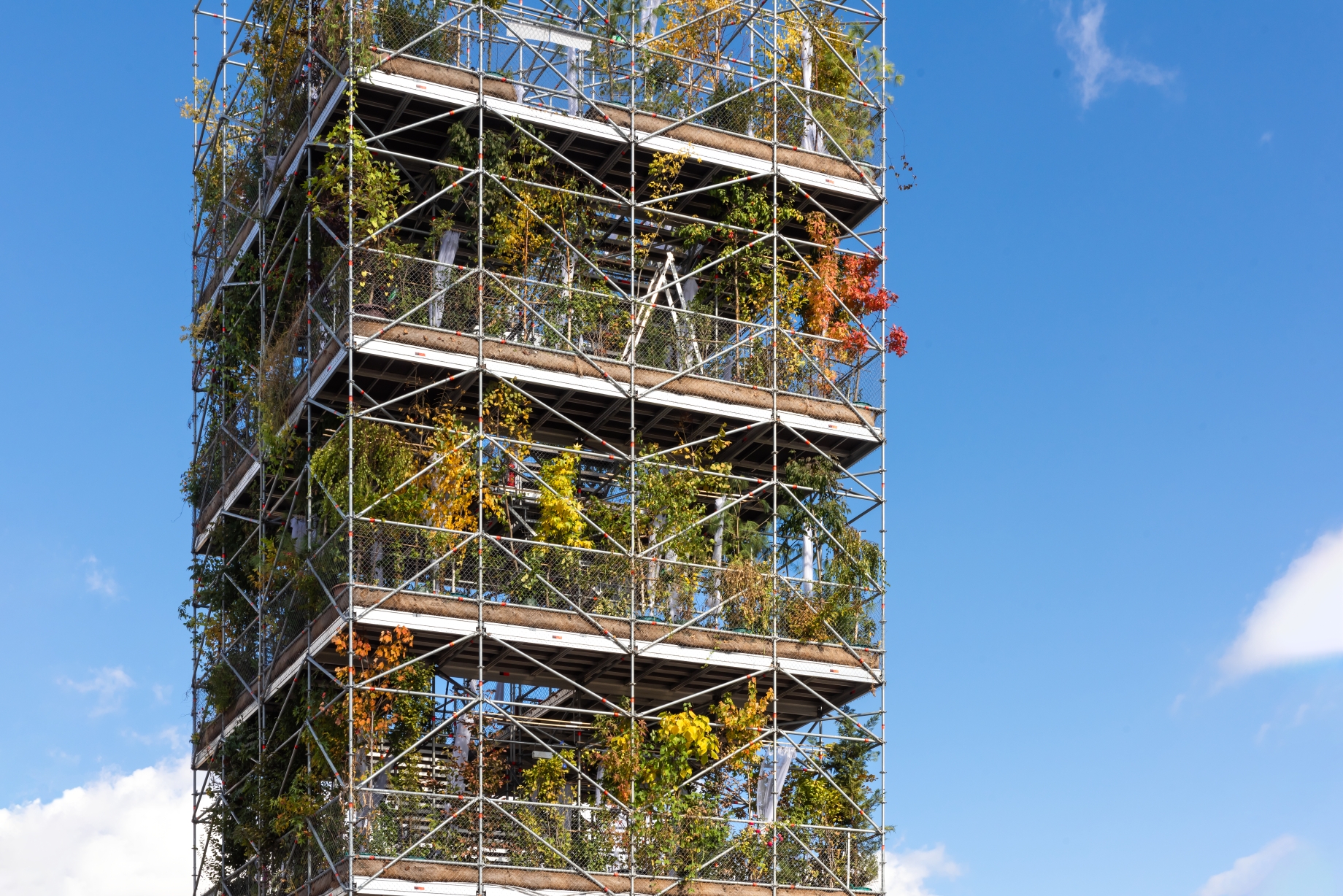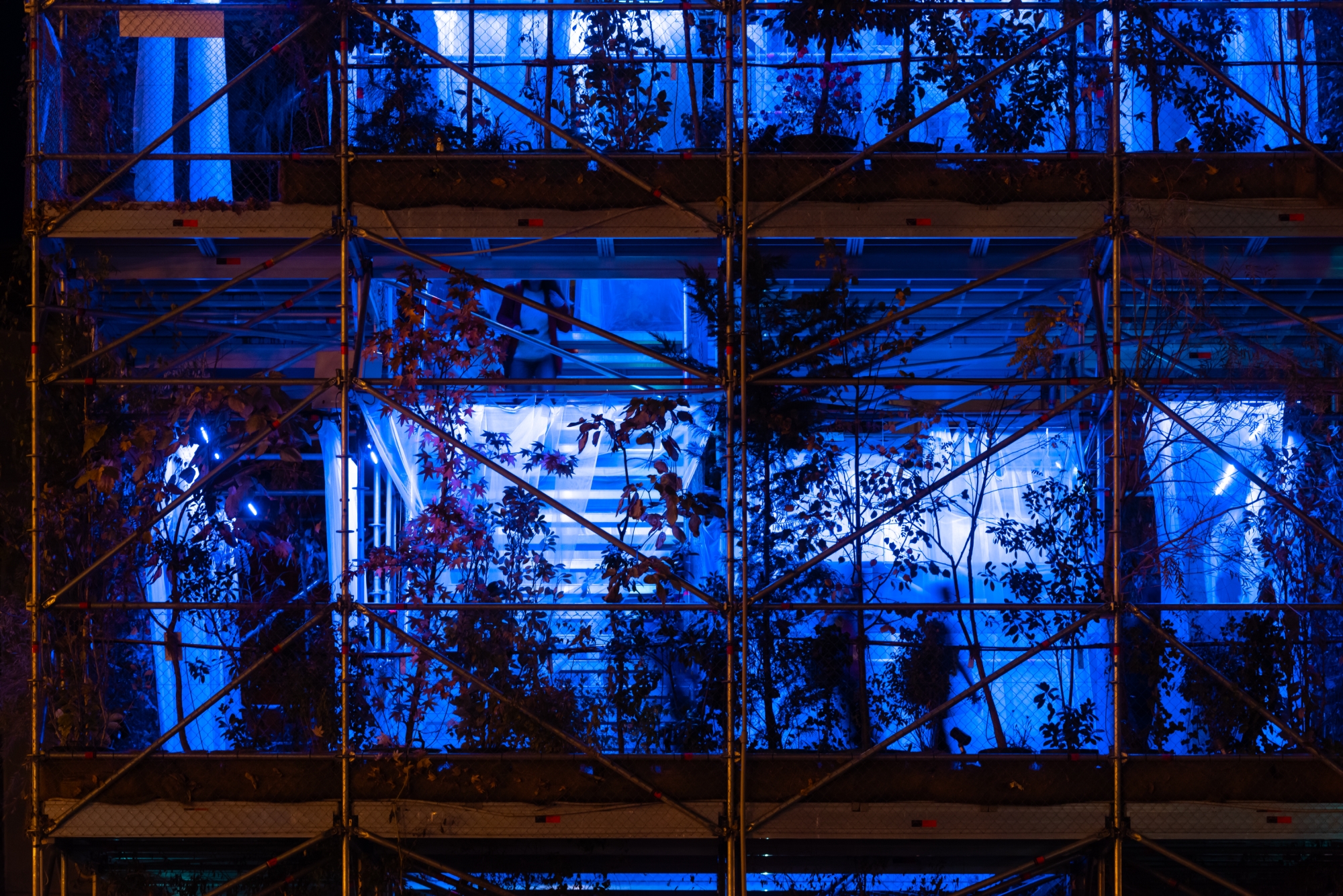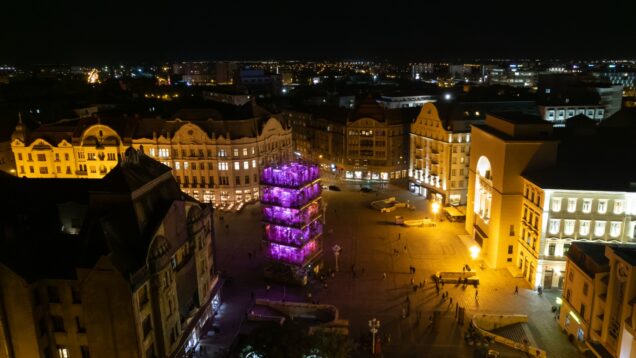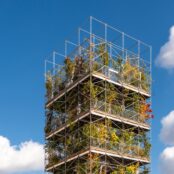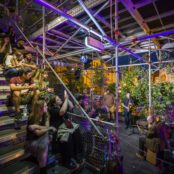In 2023, Timisoara was European Capital of Culture. The program was based on several components, one of which was the section Places relating to the city’s spaces – old and new, to urban regeneration and discussions about the city’s future.
One of the main interventions of the European Capital program was the Nursery – a provisional tower located in the space with the greatest symbolic importance in Timisoara. The project due to a collaboration with the Order of Romanian Architects – Timis Territorial Branch, was spectacular and has become one of the European Capital’s symbols. While it became an instant icon, it is not one of the strong, yet meaningless objects we see so often today, but an instrument for debate and urban transformation. 5 months since its opening, Ștefan Ghenciulescu – editor-in-chief Zeppelin – have talked about its purpose and importance (and also about the sometimes-harsh reactions it caused) with representatives of the team that made it possible: Cosmina Goagea (Timisoara 2023 curator – the “Places” Territory), Alexandra Trofin (OAR Timis), MAIO Architects (Barcelona), Alexandru Ciobotă, Raluca Rusu (Studio Peisaj, Timisoara):
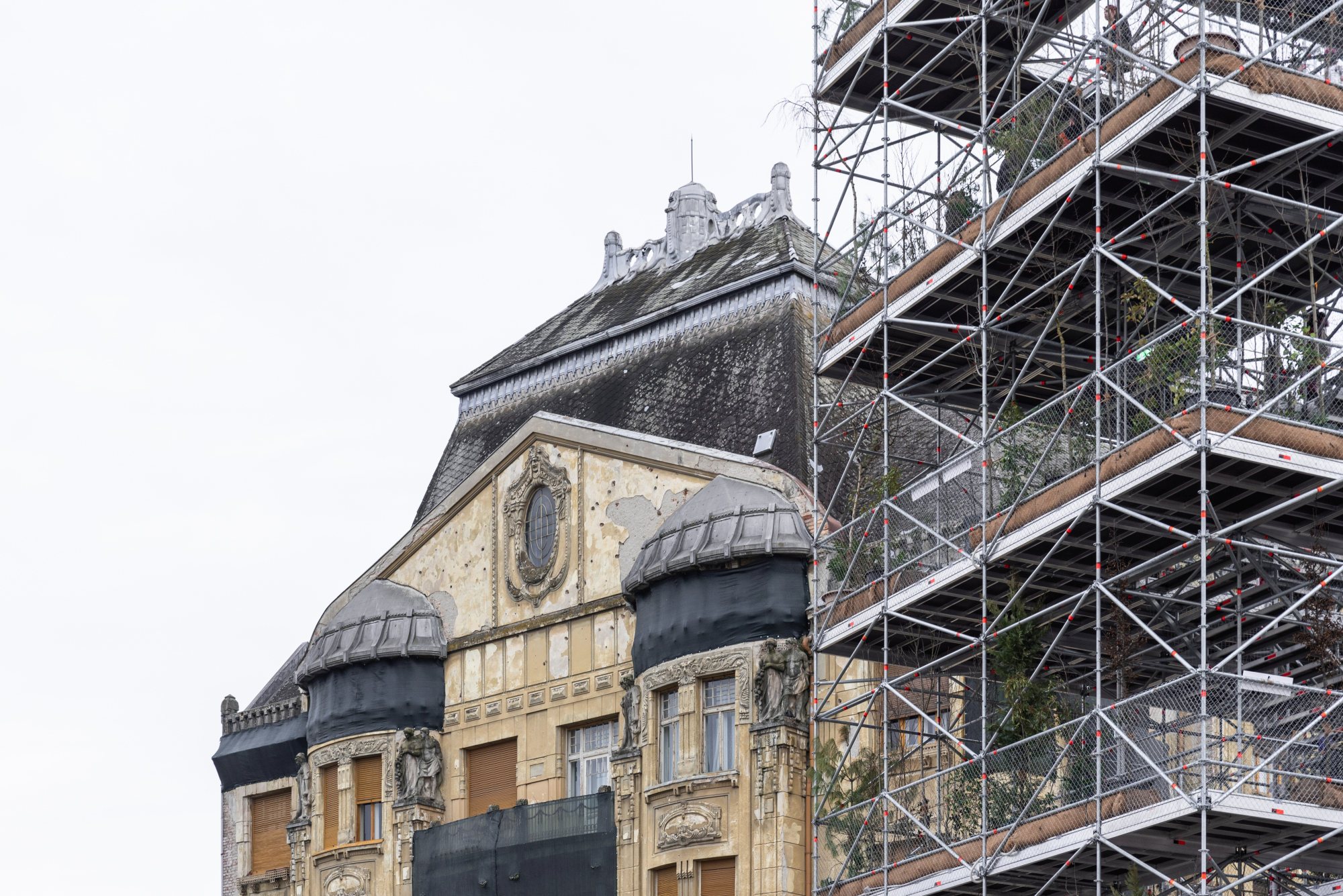 *Fertile collision. In the background, Löffler Palace, with bullet traces from the 1989 Revolution ©Marius Vasile, 02.2023
*Fertile collision. In the background, Löffler Palace, with bullet traces from the 1989 Revolution ©Marius Vasile, 02.2023
Interview: Ștefan Ghenciulescu
Photo: Marius Vasile, Laurian Ghinițoiu
Ștefan Ghenciulescu: The garden tower is a super-hot topic. Comments about the work are less wild now than a couple of months ago, and also a lot more positive. However, I get the impression that a lot of us still don’t get the how and the why of the whole operation. I would start by asking you about the start of the project. Why, why there, what is the relation to the Cultural Capital? Why spend money on this?
Cosmina Goagea: The title of European Capital of Culture is a huge opportunity for transformation, a laboratory for condensed urban processes, for which more time would have been otherwise needed, or for which there would never be any money, or that, simply, would never make the agenda of public priorities. The Cultural Program has undertaken, since the beginning, to revisit heritage and to redefine Timisoara’s identity as an avant-garde, multicultural and dynamic space, a place where worlds meet up and find common languages in real time these forces shape a culture of being together – that is, the city itself.
The agenda for Places, the territory I curate, and which also includes the Nursery, consists of identifying and supporting urban regeneration vectors and the quick validation or invalidation of ideas, instruments, artistic practices, formats of cultural intervention in the public space – in dialogue with the city’s inhabitants.
Well, it is precisely the start of this dialogue that I see as one of the gains of the Victoria Square Nursery now, 5 months since its opening. The project theme explicitly requested that the intervention should function for one year as an urban activator, problematizing how public space is created, used and perceived by people, in a complicated context, hoping to generate new meanings, a new feeling of community and which, with a great deal of luck, should lead, in time, to a new social contract. Obviously, it took a lot of courage for such an intense gesture as a metal tower of plants, among best-quality built heritage, on a memory so powerfully charged with memory and symbols. The first reactions were fiery, the Nursery had its friends and challengers ever since construction site phase, we all confronted our comfort, none of us stayed detached. In the meantime, opinions have nuanced, there is now talk of what value means in the city, whether beauty is more important than well-being, how we are cultivating the botanical heritage as Timisoara’s identity footprint; sealing up land through mineral surfaces in urban plazas is questioned, as well as the means to make room for the other forms of life with which we co-exist, with increased awareness and care; we debate how we support the people’s right to the city, of who is in fact the winner, and who makes the decisions. An iconic, disruptive installation, which triggers the negotiation of disagreement and brings all these topics in the public discourse – I’d say we got our money’s worth.
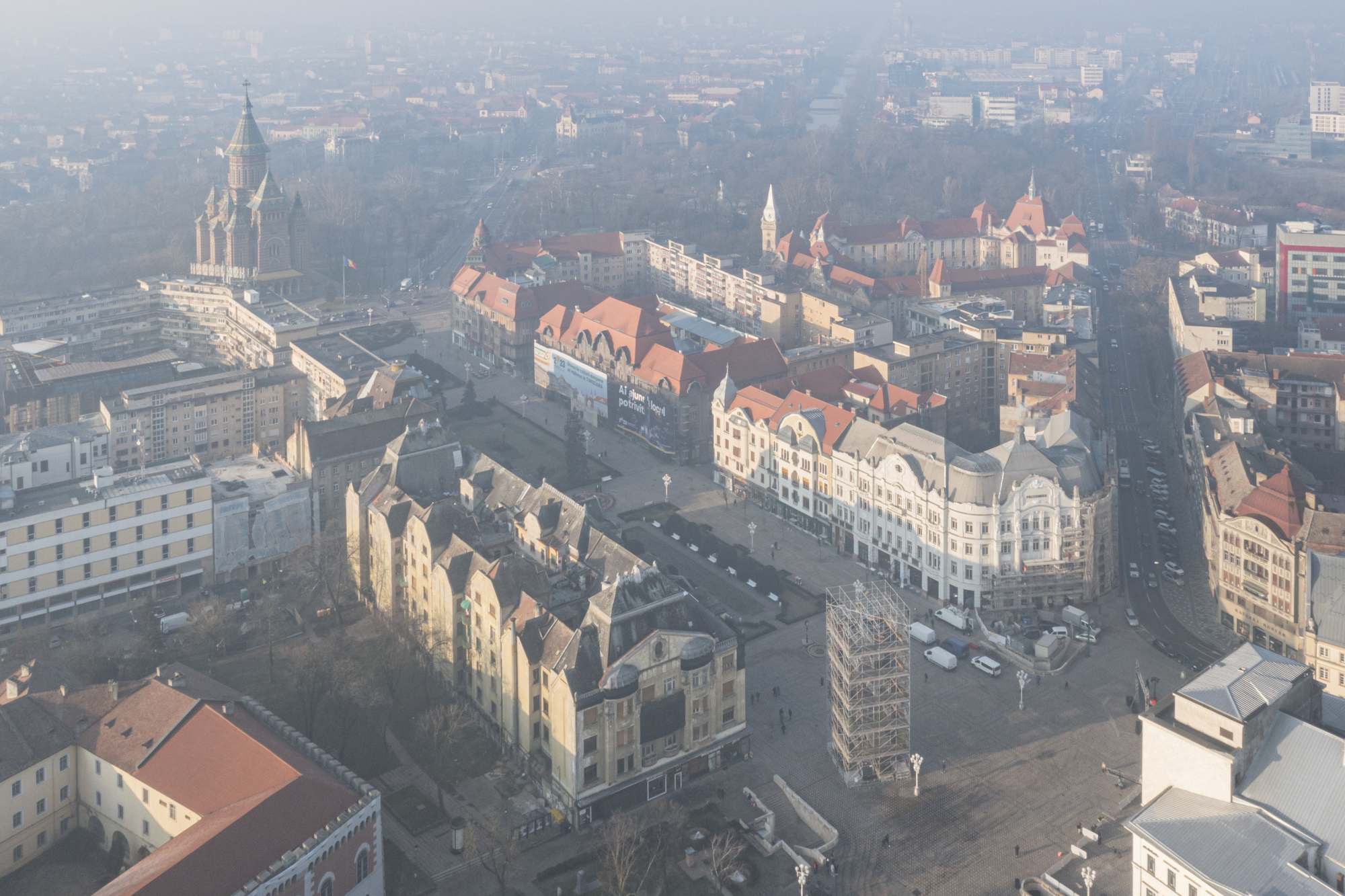 *The tower is placed so as not to restrict the view of the Cathedral from Alba Iulia Street or of the Balcony of the Palace of Culture (Opera) from the Victoriei Square. The Balcony is THE symbolic architectural element of the 1989 Revolution. Rotating the tower out of the general alignment allows for unique exterior and interior connections to the historic buildings and spaces. It alsdoemphasizes the autonomous and transient nature of the intervention ©Laurian Ghinițoiu, 02.2023
*The tower is placed so as not to restrict the view of the Cathedral from Alba Iulia Street or of the Balcony of the Palace of Culture (Opera) from the Victoriei Square. The Balcony is THE symbolic architectural element of the 1989 Revolution. Rotating the tower out of the general alignment allows for unique exterior and interior connections to the historic buildings and spaces. It alsdoemphasizes the autonomous and transient nature of the intervention ©Laurian Ghinițoiu, 02.2023
Alexandra Trofin: Victory Square is indeed an extremely sensitive place in Timisoara – the main square, emotionally loaded, the place where the Revolution sparked in 1989. But at the same time, it is a totally outdated square, from a completely different period of time, one that cannot integrate the expectations people have on public space in the present. The original design from the 1900s didn’t change too much, it was designed as a promenade and it became pedestrian only 30 years ago, however it doesn’t really function as a proper square. Even if there is quite a generous surface of green area, it works as ornamental carpets structuring the circulation, dividing (aggressively) the space. Of course, it is forbidden to step, sit or use in any way the green areas. (An important aspect we discovered during the process is that locals are very proud of the fact that people have such a strong respect towards the green areas in the square that they didn’t step on the grass not even during the 1989 Revolution).
An incredible opportunity was under discussion – an architecture competition for redesigning the square, which is actually going to be launched soon. This is the general framework in which we started the project, in early summer 2022.
Our contribution (OAR Timis) to the bid book and to the Cultural Program Timisoara 2023 – European Capital of Culture was a long-term program called Breathing Spaces (Spații Vii), a continuation of Look at the City (Privește Orașul) – a campaign encouraging the appropriation and responsibility towards public space. Over the years we had a lot of different experiences when activating public spaces through cultural programmes and temporary installations, usually in neglected, forgotten spaces, but we were planning to tackle at some point the dysfunctionalities of a central space. So, it was the right moment to focus on the Victory Square, and the TM2023 curatorial team encouraged and invited us to do so.
In the brief we prepared we asked for a temporary installation that can explore various perspectives regarding this specific square, use of space, behaviours, and narratives. Why spend money on this? Because all the stories we tell during this year could be integrated in the final design, the activities, and scenarios we test now can generate a stronger proposal. In a flat landscape where all rooftops are private, therefore not accessible for everyone, a vertical extension of the square offers an unique view over the city, while providing information regarding the heritage of Timisoara – both built and botanical. At the same time, the installation works as a place for events, an alternative outdoor cultural infrastructure for small-scale activities like gardening workshops, micro-exhibitions, guided tours but also as a scene for sound and movement performances when it attracts people around it, in the square.
MAIO: That seems to us a very pertinent and absolutely necessary question.
The project started as a statement towards public space. From the very beginning, even in the title that we thought for the installation: 1306 plants for Timisoara, we wished for the construction to be understood as a general reflection on decision making policies about public space and, specifically, about its management, in this case through greenery.
Timisoara is undergoing a process of urban transformation. We had in mind the transformation of Liberty Square, where part of the green was removed and substituted by a pavement, and of course, we also had in mind the future transformation of Victory Square, a very symbolic and visible place proposed in the curators’ brief. As foreigners, we have experienced similar processes in Barcelona, where the so-called hard squares, such as Plaça de dels Països Catalans, were taking over for years. That was three decades ago, and luckily nowadays a new understanding of a friendlier and more sustainable public space -from its drainage to how it allows ecosystems to live together- has flourished.
In fact, we claim that the installation could be seen as an open test for how public space can be used, designed, and perceived. People are invited to understand plants as agents able to regulate climate in cities but also to boost public occupation. Having in mind the future urban transformations of the area, we also wanted to open new perspectives and debates around the uses and temporalities of the city and its engagement with various communities and institutions. Once finished its temporal lifecycle, after hosting them, the intervention will provide new trees and plants to be planted around the City, following a 100% re-use logic. The open debate about how, and where, becomes therefore central to the core of the installation.
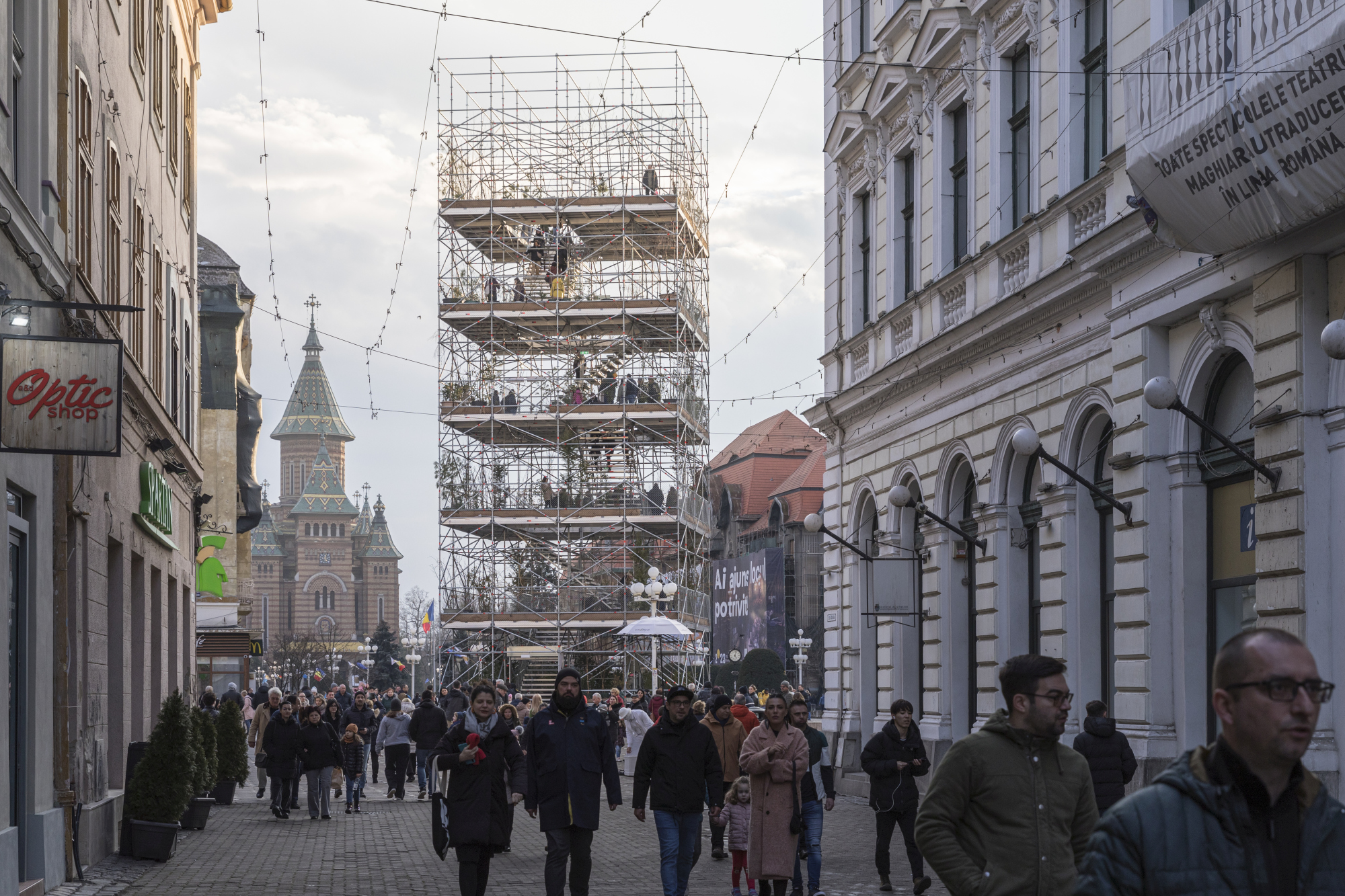 *View from Alba Iulia St. ©Laurian Ghinițoiu, 02.2023
*View from Alba Iulia St. ©Laurian Ghinițoiu, 02.2023
Of course, for a city such as Timisoara, hosting the European Capital of Culture 2023 has a deep meaning. Not only for the city and its citizens, but also in regard to its immediate EU context, opening a dialogue with the rest of cities of Europe and the common shared guidelines among them. What is the city of the future and what role do nature and more sustainable models play in it?
In other words: for us it was less important that it was a tower -or its materiality-, than the fact that the installation -a temporary nursery- contains plants that in the future will be planted along the city generating a debate about its future urbanism. We are also aware that these are complex topics and mediation can be a very helpful tool to make them accessible to citizenship.
Ș. G.: What are the essential ideas and features of the project? Including the urban one, the placement, the relation to the space? Is the main discourse about heritage, provisional landmark, ecology, our relation to the city? There were voices that saw the project as just a symbolic ‘green’ operation.
MAIO: The fact that the tower adds a new dimension to the contemplation of the square shouldn’t be at odds with the fact that the project also aims to boost an urban and political debate. For us the installation only becomes successful when those layers are fulfilled. We would like to avoid as much as possible the image of the installation as a green folly, a topos that sadly has become a greenwashing cliché lately. That would lead to a misunderstanding of the proposal, to a very superficial approach to it.
In the last decades we have witnessed a process of blackboxing, a process of occultation of the assets of cities and their management. Bringing to the centre of the city a public nursery, aims to make visible a layer that sometimes remains hidden.
Therefore, it is extremely important for us that the message and the statement about the policies and public spaces can be raised. The open debate around the future of the plants, as mentioned before, should be central to it.
Ș. G.: About the evolution of the project. How did Studio Peisaj come in? What is the idea of the garden, for now and after the dismantling?
MAIO: We were very lucky to be introduced and proposed to work with them. They have added to the proposal multiple layers with intelligence and criticality, always with a deep contextual knowledge – ranging from local species to the cultural tradition of horticulture in the area. They are also aware of the role that nature and, more broadly, new forms of urbanism will play in the future of our cities.
In practical terms, this urban nursery integrates different layers of greenery, from perennial species of trees, shrubs and flowering plants, to annual species (productive and ornamental)- produced in community gardens in Timisoara or at horticultural research and higher education institutions from the city. Besides biodiversity as a central identity element of Timisoara, the project is about care and a pedagogical and social dimension.
Gardens were, among other places, pedagogical spaces, places of encounter. And, as contemporary public spaces, also spaces for dissent and agonism. It is great that the installation produces constructive conversations about the future, the city and its inhabitants within a frame that goes far beyond the scale of humans and the city itself.
Alex Ciobotă, Raluca Rusu: The identity relationship with nature is one of Timisoara’s indicators. Currently, the local nature is either too idealized and dressed up in a veil of nostalgia, or a diffuse landmark rooted in a lamented past (the city of flowers, of parks, the city on the Bega river etc.).
The Nursery. 1306 Plants for Timisoara is a conjuring of nature, inserting in Timisoara’s public space current topics of our society, such as the climate function of vegetation, the (bio)diversity resource, the horticultural heritage and the nature’s capacity of supplying food and remedies.
The idea that the public space was also born in the shade of a tree (Philippe Rahm) is also often omitted. The pragmatic motifs of thermal comfort and the capacity of the sole tree of being the centre, were the premises of the social contract. The collective estrangement from nature, alongside the austerity of the public space, is due, on the one hand, to the technologization of individual thermal comfort (heating and colling installations), but also to the mineral vision of modern urbanism.
The suggested (bio)diverse compositions bring homage to local landscaping horticulturalists (Wilhelm Múhle, Frantz Niemetz and others), who cultivated land in commercial and public gardens, contributing to the city’s booming international reputation. The involvement in the city’s landscaping concept and in the development of modern European horticulture shows us a complex relation with nature and an active entrepreneurial attitude.
Nature’s nutritive capacity is generous. Yet, gastronomical culture is rather modest, also affected, among others, by globalization; we are still looking past the food nearby and past our own imagination in the kitchen. We believe in providing access to local, healthy food, in horticultural engineering, in local production, as well as in the move towards community gardening.
From another perspective, the installation entails a scenic urban experience between two hypostases. The first one is that of existing and of looking from the outside at the (horizontal or vertical) nature, which is much too often regarded as just a decor. The second hypostasis is immersive, is of being part of the ecosystem, of living in the life of the other living entities, a sort of ecocentrism. It is a game of positioning, which subtly refers to how we choose our future.
In its essence, the Nursery‘s garden represents a large circuit of natural processes. In particular, it grew in the local nursery and, once the installation is dismantled, will become a diffuse collective garden. Its vegetal components become the memory of the Nursery and of Timisoara – 2023 European Capital of Culture, improving the city’s landscape.
The Nursery, across 2023
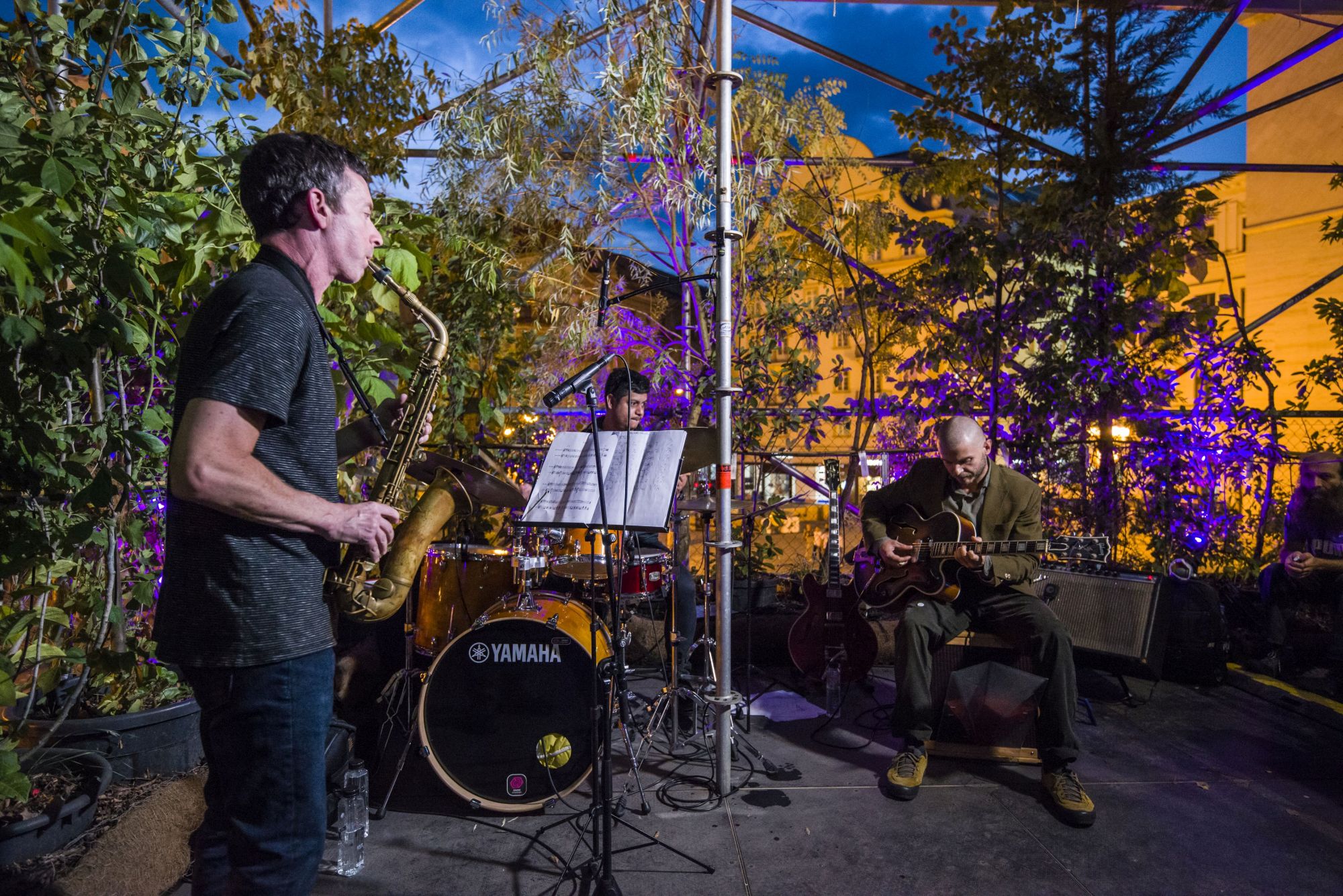 *Sian Brie Trio live concert © Bianca Purice-Azap & Dan Purice
*Sian Brie Trio live concert © Bianca Purice-Azap & Dan Purice
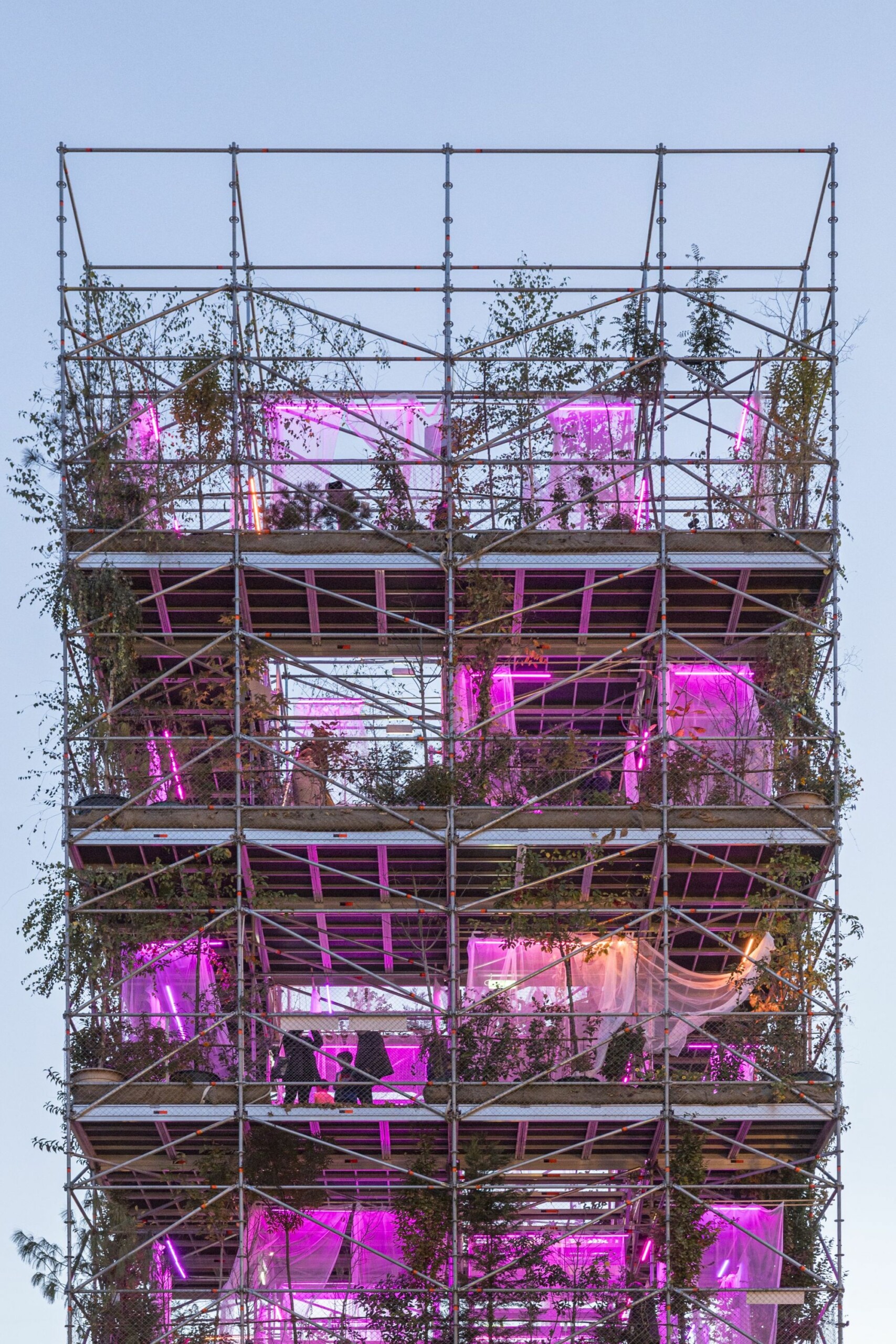 *VIU (Alive, in romanian): A celebration of Life installation ©Laurian Ghinițoiu
*VIU (Alive, in romanian): A celebration of Life installation ©Laurian Ghinițoiu
Update (january 2024):
The Nursery was nominated for the EU Mies van der Rohe Awards and included in the jury’s 40 projects selection.
Info & credits
Organiser: The Ordeer of Romanian Architects – Timiș Branch
Project team: Anca Teslevici, Alexandra Trofin, Ema Cristescu, Georgiana Spiridon, Antoniu Sicra
Curator of Timișoara 2023 – European Capital of Culture, Territory “Places”: Cosmina Goagea
Graphic design: Ștefan Lucuț
Installation concept author: MAIO Architects – Maria Charneco, Alfredo Lérida, Guillermo López, Anna Puigjaner
Concept collaborators: Simone Marcolin, Ilaria Donadel, Filippo Tognocchi, Ignasi Sarria
Architecture project and lighting design: Studio Nomadic – Victor Popovici, Silvia Tripșa, Nicoleta Postolache
Design with nature: Studio Peisaj – Alexandru Ciobotă, Raluca Rusu
Structural project: Echo Universal – Balint Karoly
Scaffolding collaborator: ABT Motion Rigs, Salt Box
Specialities collaborators: Blaser – Bogdan Sere, DeBoot – Silvian Tecu, Melbo Instal – Emilian Zmeu, Emesis – Mihai Cojanu, Irigarden – Cătălin Lubeniță
Site management: Bianca Pasc, Molnar Ovidiu
Content collaborators: Tur de Arhitectură
Partners: Horticultura S.A., Universitatea de Științele Vieții „Regele Mihai I” din Timișoara, Comunitatea GreenFeel Timișoara
Special thanks for their support and advice during the development of the project to: Brîndușa Tudor, Matevž Čelik, Rudolf Gräf, Silviu Scrob; Colegiul Director OAR Timiș, echipa Centrului de Proiecte, echipa Primăriei Municipiului Timișoara, Direcția Județeană pentru Cultură Timiș
This project was part of the Cultural Programme Timișoara 2023 – European Capital of Culture and is co-founded by Timișoara City Hall through the Center for Projects and The Romanian Order of Architects through the Architectural Stamp Duty
Powered by: Banca Transilvania

